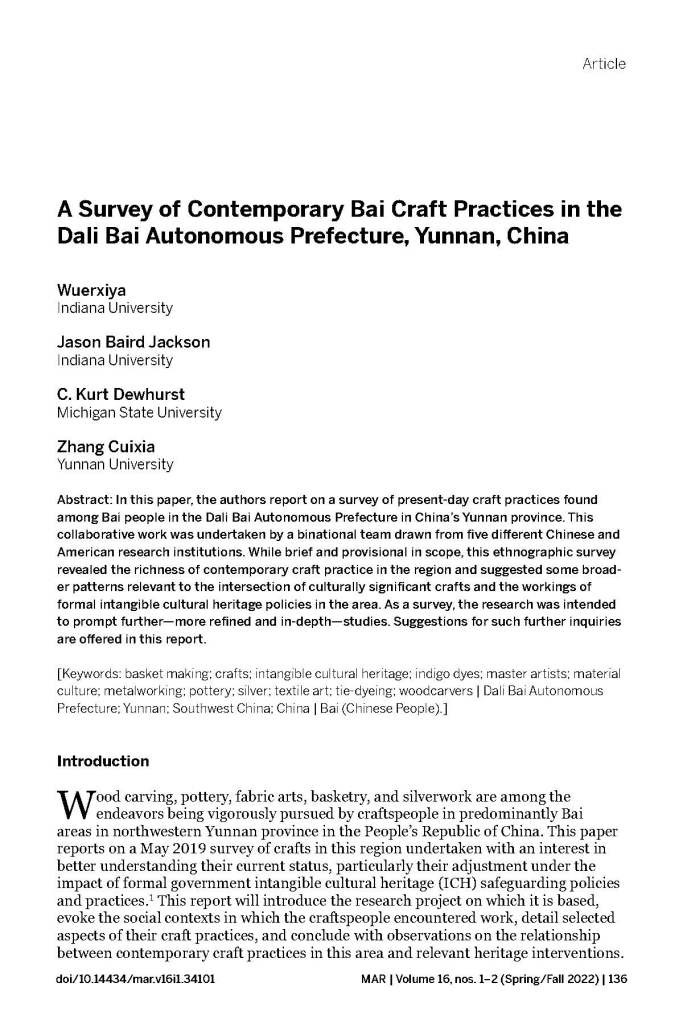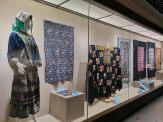I am here using a blog post not to share current news, but to get an older document online and linkable. What follows is the short (public) and long (unseen, for peer-review) abstracts from the panel “Material Culture Studies among the Baiku Yao of China’s Guangxi Zhuang Autonomous Region” presented at the 2018 American Folklore Society Annual Meeting (October 18, 2018, Buffalo New York). My intention is to link to this post from a new (February 2020) page for the “Collaborative Work in Museum Folklore and Heritage Studies” (sub-)project.
Material Culture Studies among the Baiku Yao of China’s Guangxi Zhuang Autonomous Region
In this Diamond session, participants will share preliminary results from ongoing field research among the Baiku (White Trouser) Yao people of Nandan County in China’s Guangxi Zhuang Autonomous Region. Presentations will explore aspects of local Yao material culture, with a special focus on fabric arts and basketry. The presenters share an interest in the ways that these craft activities are being impacted by such cultural heritage practices as master artisan designations, cultural tourism, and eco-museum-based community documentation projects. The field research is one part of the American Folklore Society and China Folklore Society’s joint Folklore and Intangible Cultural Heritage Project.
Material Culture Studies among the Baiku Yao of China’s Guangxi Zhuang Autonomous Region
In this Diamond session, participants will share preliminary results from ongoing field research among the Baiku (White Trouser) Yao people of Nandan County in China’s Guangxi Zhuang Autonomous Region. Presentations will explore aspects of local Yao material culture, with a special focus on fabric arts and basketry. The neighboring villages of Huatu, Manjiang, and Huaili, where the panelists have pursued joint field research under the auspices of the American Folklore Society and China Folklore Society’s joint Folklore and Intangible Cultural Heritage Project, are communities with a high level of engagement with cultural heritage initiatives, the most visible of which is the Nandan Baiku Yao Eco-Museum, with which the researchers have partnered. The presenters share an interest in the ways that craft activities are being impacted by such cultural heritage practices as master artisan designations, cultural tourism, and eco-museum-based community documentation projects.
Kurt Dewhurst will present an overview of the team’s 2017 work in Guangxi and situate it in relationship to the larger projects of which it was a part. Jason Baird Jackson and Lijun Zhang will report on the team’s studies of bamboo basketry among the Yao, tracking baskets from making to marketing to household use. Miaomiao Fan and Marsha MacDowell will discuss Baiku Yao textile arts, characterizing the status of textiles, especially clothing arts, inside and outside the local community. Xiaoyan Liang and Jon Kay will both report on aspects of the video documentary work pursued during the December 2017 fieldwork, offering general reflections arising from the specific experiences of each filmmaker.
While some studies of the Baiku Yao have been published in Chinese ethnological scholarship, English-language studies are rare and focus mainly on Baiku Yao participation in eco-museum development (Nitzky 2012, 2014; Yi 2013). Within the larger literatures on the Yao peoples in the Southeast Asia Massif, Yao textiles have received considerable attention, but those of the Baiku Yao are distinctive and little documented (cf. Pouret 2002). English-language scholarship on basketry among the Yao is nonexistent, a situation that holds largely for the minority nationalities of Southwest China as a whole. These peoples and their diverse and impressive utility baskets are largely left out of surveys of Chinese basketry (Kwan 2010, but see Fei and Chang 1945). Sophisticated treatments of Yao culture, society, history, and circumstances in modern China by Western scholars have not yet taken up the circumstances of the Baiku Yao specifically (ex. Litzinger 2000) and the Baiku Yao situation has similarly not been considered in the context of larger comparative discussions of the region and its peoples (Chio 2014; Scott 2009; Turner, Bonnin, and Michaud 2015). Future work by the binational team aims to bridge Chinese-language and English-language scholarship on the Yao and their neighbors and, as in this panel, to begin introducing English-speaking audiences to the Baiku Yao. The team also aims to further connect its studies among the Baiku Yao to wider Chinese-Language and English-language work on cultural heritage (ex. An and Yang 2015; Hafstein 2012; Noyes 2017; Song 2015; Zhang 2014).
References Cited
An, Deming, and Lihui Yang. “Chinese Folklore Since the Late 1970s: Achievements, Difficulties, and Challenges.” Asian Ethnology 74, no. 2 (2015): 273–90.
Chio, Jenny. A Landscape of Travel: The Work of Tourism in Rural Ethnic China. Seattle: University of Washington Press, 2014.
Fei, Xiaotong, and Tse-i Chang. Earthbound China: A Study of Rural Economy in Yunnan. Chicago: University of Chicago Press, 1945.
Hafstein, Valdimar T. “Heritage.” In A Companion to Folklore, edited by Regina F. Bendix and Galit Hasan-Rokem, 500–519. Blackwell Companions to Anthropology. Malden, MA: Wiley-Blackwell, 2012.
關善明 [Simon Kwan]. 中國竹籃 [Chinese Basketry]. Hong Kong: 沐文堂美術出版社 [Muwen Tang Fine Arts Publication], 2010.
Litzinger, Ralph A. Other Chinas: The Yao and the Politics of National Belonging. Durham, NC: Duke University Press, 2000.
Nitzky, William. “Mediating Heritage Preservation and Rural Development: Ecomuseum Development in China.” Urban Anthropology and Studies of Cultural Systems and World Economic Development 41, no. 2–4 (2012): 367–417.
Nitzky, William. “Community Empowerment at the Periphery? Participatory Approaches to Heritage Protection in Guizhou, China.” In Cultural Heritage Politics in China, edited by Tami Blumenfield and Helaine Silverman, 205–32. New York: Springer, 2013.
Nitzky, William David. “Entanglements of ‘Living Heritage’: Ecomuseum Development in Rural China.” Dissertation, Arizona State University, 2014. http://hdl.handle.net/2286/R.I.25920.
Noyes, Dorothy. Humble Theory: Folklore’s Grasp on Social Life. Bloomington: Indiana University Press, 2017.
Pourret, Jess G. The Yao: The Mien and Mun Yao in China, Vietnam, Laos and Thailand. London: Thames & Hudson, 2002.
Scott, James C. The Art of Not Being Governed: An Anarchist History of Upland Southeast Asia. New Haven: Yale University Press, 2009.
Song, Junhua. “An Analysis of the Current Situation and Problems of the Digital Protection of Chinese Intangible Cultural Heritage.” Cultural Heritage, 6 (2015):10-23.
Turner, Sarah, Christine Bonnin, and Jean Michaud. Frontier Livelihoods: Hmong in the Sino-Vietnamese Borderlands. Seattle: University of Washington Press, 2017.
Yi, Sabrina Hong. “Examining the Suojia Ecomuseum and the Nandan Ecomuseum in China.” In ACAC 2013 : Proceedings of the Asian Conference on Arts and Cultures, 168–77. Bangkok, Thailand: Srinakharinwirot University, 2013. http://dro.deakin.edu.au/view/DU:30055238.
Zhang, Lijun. “Living with/in Heritage: Tulou as Home, Heritage, and Destination.” Dissertation, Indiana University, 2014.
The schedule of presentation from the conference program follows:
Material Culture Studies among the Baiku Yao of China’s Guangxi Zhuang Autonomous Region
Sponsored by the American Folklore Society, the Folklore and Museums Section, and the Henry Luce Foundation
Carrie Hertz (Museum of International Folk Art), chair
8:00 Collaborative International Museum Fieldwork: Joint Documentation and Learning
C. Kurt Dewhurst (Michigan State University Museum)
8:15 From Maker to Marketplace: Aspects of Basketry Among the Baiku Yao
Jason Baird Jackson (Mathers Museum of World Cultures, Indiana University)
8:30 Continuity and Transformation: Basketry, Personal History, and Community Life
Lijun Zhang (Anthropological Museum of Guangxi)
8:45 A Probe into the Art and Inheritance of White Trouser Yao Textiles
Miaomiao Fan (Anthropology Museum of Guangxi)
9:00 Baiku Yao Textiles in the Marketplace: A Quest to Understand Traditions and Adaptations
Marsha MacDowell (Michigan State University Museum)
9:15 Ethnographic Documentary and “Return Visit” Methods in Guangxi
Xiaoyan Liang (Anthropology Museum of Guangxi)
9:30 Craft and Videography: An Ethnographic Approach and Collaborative Method
Jon Kay (Mathers Museum of World Cultures, Indiana University)
9:45 discussion

A portion of Manjiang village, a Baiku Yao community, viewed from above. December 14, 2017. Photograph by Jason Baird Jackson.
























![img_6402[1]](https://jasonbairdjackson.files.wordpress.com/2019/01/img_64021.jpg)































